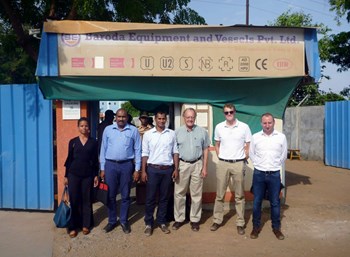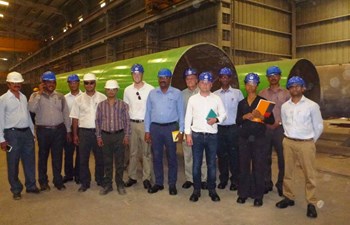ITER NEWSLINE
-
Collaboration is in the pipes
Collaboration is in the pipes

Representatives of the different parties travelled together to India in early June, in a visit initiated by Sergio Orlandi, ITER head of Plant Engineering; Laurent Schmieder, site project manager and BIPS (Buildings Infrastructure and Power Supplies) leader; and Ajith Kumar, India project leader for the cooling water system.
The installation of buried pipes for ITER's cooling water system is a first-phase assembly activity that must be carried out before other site infrastructure works for the cooling water system can be initiated.
While the design and procurement of the Component Cooling Water System (CCWS), the Chilled Water System (CHWS) and the Heat Rejection System (HRS)—including piping—is part of India's procurement responsibilities for ITER, the European Domestic Agency is responsible for the installation of the buried piping for these systems on the platform.
The work will fall under a general infrastructure contract signed between Europe and the consortium Spie Batignolles Group (Spie Batignolles TPCI /Valérian/ADF) for on-site electricity and hydraulic networks.
As the start date of on-site infrastructure works approaches, close collaboration among the different parties is essential in order to ensure the best possible coordination between the arrival of the material and the work schedule for buried installation on site. The first deliveries from India have already reached ITER, closely monitored by representatives of the Indian and European Domestic Agencies, the ITER logistics team, and European contractors.

Standing in front of cooling water pipes CCWS1 in the Indian factory. The installation of buried piping will begin this summer.
In the same collaborative spirit, representatives of the European Domestic Agency, architect engineer ENGAGE and implementation contractor ADF were invited to visit India together in early June, welcomed by the Indian Domestic Agency and contractor Larsen & Toubro. The aim was to review the coherence of manufacturing, delivery and installation schedules; discuss the site work procedures and quality processes to be respected; and see fabrication first hand at the factory.
The visit was productive for all and all deliveries corresponding to the first phase of site works are confirmed. The European contractors plan to start excavation works early this summer.
return to the latest published articles








